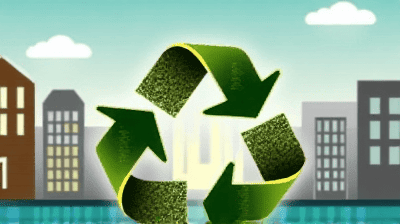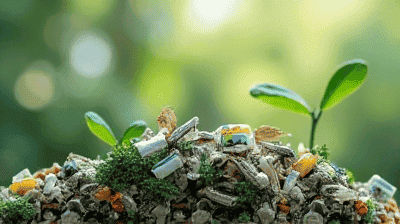
Climate change represents one of the most pressing challenges facing our planet today, necessitating urgent action across various sectors. One promising approach to mitigating climate change is the adoption of a circular economy. Unlike the traditional linear model of production and consumption, which follows a "take-make-dispose" pattern, the circular economy emphasizes sustainability and resource efficiency. By prioritizing waste reduction, resource recovery, and regenerative practices, a circular economy has the potential not only to minimize waste but also to significantly cut greenhouse gas emissions.
A circular economy is an economic system that aims to minimize waste and make the most of resources. It represents a shift away from the traditional linear economy, often characterized by excessive consumption and disposal, toward an approach that emphasizes:
The core of a circular economy is the recognition that resources are finite and that human activity must be restructured to operate within ecological limits.
Design for Longevity: Products should be designed to last longer, thereby reducing the frequency of replacement and the associated environmental impacts.
Maintain and Repair: Facilitating easy maintenance and repair can extend the lifecycle of products, promoting resource efficiency.
Reuse and Remanufacture: Encouraging the reuse of products and components can significantly reduce waste generation and the need for new resources.
Recycling: Materials should be recycled to create new products, thus closing the loop on resource use and minimizing landfill waste.
Responsible Consumption: Encouraging consumers to make informed decisions about their purchases, emphasizing quality over quantity.

Waste disposal is a significant source of greenhouse gas emissions, particularly from landfills and incineration. The major emissions associated with waste include:
Methane: Organic waste that decomposes anaerobically in landfills generates methane, a potent greenhouse gas with a global warming potential many times greater than carbon dioxide over a short time frame.
Carbon Dioxide: The incineration of waste, especially when it includes plastics and fossil-based materials, releases carbon dioxide into the atmosphere, contributing to climate change.
Reducing waste through the principles of a circular economy can lead to significant reductions in greenhouse gas emissions:
Minimizing Landfill Contributions: By reducing the volume of waste sent to landfills, we can decrease methane emissions resulting from organic decomposition.
Lowering Incineration Emissions: Reducing the amount of waste that requires incineration minimizes carbon dioxide emissions associated with burning materials.
Conserving Resources: The more efficiently we use resources, the less energy is required in manufacturing processes. This energy conservation directly correlates with lowered greenhouse gas emissions.
Several case studies highlight the potential for waste reduction strategies in cutting greenhouse gas emissions:
Sweden is renowned for its efficient waste management system, which includes extensive recycling and waste-to-energy facilities. Approximately 99% of waste in Sweden is managed through recycling, composting, or incineration with energy recovery. As a result, Sweden reports significantly lower greenhouse gas emissions related to waste handling. By recovering energy from waste, the country reduces reliance on fossil fuels, contributing to its ambitious climate targets.
The Ellen MacArthur Foundation has been instrumental in promoting the circular economy. Its research demonstrates that transitioning to a circular economy could lead to a reduction of up to 70% in greenhouse gas emissions in specific sectors, especially textiles and food. By focusing on sustainable design, resource recovery, and waste minimization, businesses can reduce their carbon footprints substantially.
To facilitate a successful transition to a circular economy, it is essential to design products and systems that embrace sustainability. Key design strategies include:
Promoting effective recycling programs can significantly reduce waste and emissions. Key steps include:
Businesses can embrace circular economy principles through innovative business models that prioritize waste reduction:
Product-as-a-Service: Instead of selling products outright, companies can offer products as a service, retaining ownership and responsibility for the lifecycle of the product. This encourages companies to optimize for durability and recyclability.
Take-Back Programs: Establishing take-back programs enables consumers to return end-of-life products for refurbishment, recycling, or responsible disposal.
Collaboration among stakeholders—governments, businesses, and communities—is vital for creating a circular economy. This can be achieved through:
Public-Private Partnerships: Collaborations that promote sustainable practices and create policies supporting the circular economy can drive significant progress.
Shared Platforms: Creating platforms for sharing resources, equipment, and knowledge among businesses can enhance circularity and sustainability.
Government policies play a crucial role in enabling the transition to a circular economy. Effective strategies may include:
Incentives for Waste Reduction: Governments can provide financial incentives for businesses and consumers that engage in waste reduction practices, such as tax breaks or grants for sustainable projects.
Regulatory Frameworks: Implementing regulations that mandate recycling, waste reduction targets, and sustainable practices can create an enabling environment for the circular economy.

Beyond the environmental advantages, embracing a circular economy provides numerous societal and economic benefits:
Transitioning to a circular economy can lead to the creation of new jobs in various sectors, including recycling, repair, sustainable design, and eco-tourism. This shift not only contributes to economic growth but also fosters a more resilient workforce equipped with the skills needed for the green economy.
By reducing dependence on virgin resources, a circular economy enhances resource security. Utilizing recycled materials minimizes the pressure on natural resources and mitigates the risks of supply chain disruptions.
Communities that adopt circular practices are often more resilient to economic fluctuations and environmental changes. By fostering local economies and promoting sustainable practices, communities can thrive while reducing their environmental impact.
Businesses that embrace circular economy principles can enhance their competitiveness by reducing costs associated with waste disposal and resource procurement. Furthermore, adopting sustainable practices can improve brand reputation and attract environmentally conscious consumers.
Shifting from a linear to a circular economy requires significant changes in consumer behavior and business practices. Overcoming deeply ingrained consumer habits of disposable culture can be challenging and necessitates education and outreach.
Implementing circular economy practices often requires advanced technologies for recycling, resource recovery, and product design. Developing and adopting these technologies can pose challenges for businesses, particularly small and medium enterprises.
The transition to a circular economy may require upfront investments in new technologies, infrastructure, and training. While the long-term benefits often outweigh these costs, securing funding for initial investments can be a barrier for some organizations.

The circular economy presents a transformative approach to addressing climate change and its associated greenhouse gas emissions. By reducing waste and promoting resource efficiency, we can significantly mitigate the impacts of climate change while reaping economic benefits.
Embracing circular economy principles requires collaboration among governments, businesses, and communities, along with a commitment to sustainable practices. As we navigate the challenges of climate change, adopting a circular economy can pave the way for a more sustainable, resilient, and prosperous future.
Through innovative design, improved recycling, and responsible consumption, we have the opportunity to lessen our environmental impact and support a thriving economy that respects the planet's finite resources. By committing to this transition, we can secure a sustainable future for generations to come.